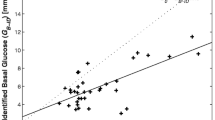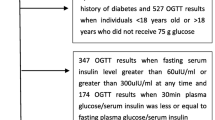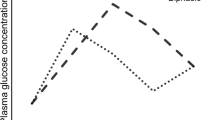Abstract
Insulin secretion and insulin sensitivity indexes are related by hyperbolic functions, allowing the calculation of the disposition index (DI) as the product of the acute insulin response (AIR) and the insulin sensitivity index (Si) from intravenous glucose tolerance test (IVGTT). Our objective was to develop an oral-DI based on the oral glucose tolerance test (OGTT) and to assess its association with glucose tolerance status. This research is structured in three studies. Study 1: OGTT were performed in 833 non-diabetic Chilean women (18–60 years) without family history of diabetes mellitus. Study 2: an independent group of n = 57 non-diabetic (18–46 years) without family history of diabetes mellitus carried out an OGTT and an abbreviated IVGTT. Study 3: a sample of 1674 Chilean adults (18–60 years) with different glycaemic status performed an OGTT. An adequate statistical fit for a rectangular hyperbola was found between the area under the curve of insulin-to-glucose ratio (AUCI/G-R) and the Matsuda ISI-COMP index (study 1). The oral-DI derived as AUCI/G-R × ISI-COMP was previously termed insulin-secretion-sensitivity index-2 (ISSI-2). ISSI-2 significantly correlated with DI from IVGTT (rho = 0.34; p = 0.009) (study 2). ISSI-2 shows important differences across groups of subjects with different glycaemic status (study 3). We have confirmed that ISSI-2 replicates the mathematical properties of DI, showing significant correlations with DI from the abbreviated MM-IVGTT. These results indicate that ISSI-2 constitutes a surrogate measure of insulin secretion relative to insulin sensitivity and emphasizes the pivotal role of impaired insulin secretion in the development of glucose homeostasis dysregulation.






Similar content being viewed by others
References
Abdul-Ghani MA, Tripathy D, DeFronzo R (2006) Contributions of β-cell dysfunction and insulin resistance to the pathogenesis of impaired glucose tolerance and impaired fasting glucose. Diabetes Care 29:1130–1139
American Diabetes Association (2015) Classification and diagnosis of diabetes. Diabetes Care 38(Suppl 1):S8–S16
Arancibia C, Galgani J, Valderas JP, Morales M, Santos JL, Pollak F (2014) Evaluation of serum insulin levels after an oral glucose load for the diagnosis of insulin resistance. Rev Med Chil 142:1106–1112
Ascaso JF, Pardo S, Real JT et al (2003) Diagnosing insulin resistance by simple quantitative methods in subjects with normal glucose metabolism. Diabetes Care 26:3320–3325
Bastard JP, Vandernotte JM, Faraj M et al (2007) Relationship between the hyperinsulinemic-euglycaemic clamp and a new simple index assessing insulin sensitivity in overweight and obese postmenopausal women. Diabetes Metab 33:261–268
Bergman RN (2005) Minimal model: perspective from 2005. Horm Res 64(suppl 3):8–15
Bergman RN, Ider YZ, Bowden CR, Cobelli C (1979) Quantitative estimation of insulin sensitivity. Am J Physiol 236:E667–E677
Bergman RN, Phillips LS, Cobelli C (1981) Physiologic evaluation of factors controlling glucose tolerance in man. J Clin Invest 68:1456–1467
Bergman RN, Prager R, Volund A, Olefsky JM (1987) Equivalence of the insulin sensitivity index in man derived by the minimal model method and the euglycemic glucose clamp. J Clin Invest 79:790–800
Bergman RN, Ader M, Huecking K, Van Citters G (2002) Accurate assessment of β-cell function: the hyperbolic correction. Diabetes 51(Suppl 1):S212–S220
Cobelli C, Toffolo GM, Man CD et al (2007) The insulin secretory pathway is complex and regulated by multiple factors including glucose, protein, fat, and incretins. Am J Physiol Endocrinol Metab 293:E1–E15
DeFronzo RA, Tripathy D, Abdul-Ghani M, Musi N, Gastaldelli A (2014) The disposition index does not reflect β-cell function in IGT subjects treated with pioglitazone. J Clin Endocrinol Metab 99(10):3774–3781
Denti P, Toffolo GM, Cobelli C (2012) The disposition index: from individual to population approach. Am J Physiol Endocrinol Metab 303:E576–E586
Gerich JE (2002) Is reduced first-phase insulin release the earliest detectable abnormality in individuals destined to develop type 2 diabetes? Diabetes 51(Suppl 1):8117–8121
Herzberg-Schafer SA, Staiger H, Heni M et al (2010) Evaluation of fasting state-/oral glucose tolerance test-derived measures of insulin release for the detection of genetically impaired b-cell function. PLoS One 5(12):e14194
Holst JJ, Gromada J (2004) Role of incretin hormones in the regulation of insulin secretion in diabetic and nondiabetic humans. Am J Physiol Endocrinol Metab 287:E199–E206
Kahn SE, Prigeon RL, McCulloch DK et al (1993) Quantification of the relationship between insulin sensitivity and beta-cell function in human subjects. Evidence for a hyperbolic function. Diabetes 42:1663–1672
Lorenzo C, Wagenknecht LE, Rewers MJ, Karter AJ, Bergman RN, Hanley AJ, Haffner SM (2010) Disposition index, glucose effectiveness, and conversion to type 2 diabetes: the Insulin Resistance Atherosclerosis Study (IRAS). Diabetes Care 33:2098–2103
Marcelli-Tourvieille S, Hubert T, Pattou F, Vantyghem MC (2006) Acute insulin response (AIR): review of protocols and clinical interest in islet transplantation. Diabetes Metab 32:295–303
Mari A, Pacini G, Murphy E, Ludvik B, Nolan JJ (2001) A model-based method for assessing insulin sensitivity from the oral glucose tolerance test. Diabetes Care 24:539–548
Mari A, Ahren B, Pacini G (2005) Assessment of insulin secretion in relation to insulin resistance. Curr Opin Clin Nutr Metab Care 8:529–533
Mari A, Tura A, Natali A, Laville M, Laakso M, Gabriel R, Beck-Nielsen H, Ferrannini E (2010) RISC investigators impaired beta cell glucose sensitivity rather than inadequate compensation for insulin resistance is the dominant defect in glucose intolerance. Diabetologia 53:749–756
Matsuda M, DeFronzo R (1999) Insulin sensitivity indices obtained from oral glucose tolerance testing: comparison with the euglycemic insulin clamp. Diabetes Care 22:1462–1470
Pacini C, Bergman RN (1986) MINMOD: a computer program to calculate insulin sensitivity and pancreatic responsitivity from the frequently sampled intravenous glucose tolerance test. Comput Methods Prog Biomed 23:113–122
Plum L, Ahmed L, Febres G et al (2011) Comparison of glucostatic parameters after hypocaloric diet or bariatric surgery and equivalent weight loss. Obesity 19:2149–2157
Retnakaran R, Shen S, Hanley AJ et al (2008) Hyperbolic relationship between insulin secretion and sensitivity on oral glucose tolerance test. Obesity 16:1901–1907
Retnakaran R, Qi Y, Goran M, Hamilton J (2009) Evaluation of proposed oral disposition index measures in relation to the actual disposition index. Diabet Med 26:1198–1203
Ritzel RA, Butler AE, Rizza RA, Veldhuis JD, Butler PC (2006) Relationship between beta-cell mass and fasting blood glucose concentration in humans. Diabetes Care 29:717–718
Stumvoll M, Mitrakou A, Jenssen T et al (2000) Use of the oral glucose tolerance test to assess insulin release and insulin sensitivity. Diabetes Care 23:295–301
Tura A, Sbrignadello S, Succurro E et al (2010) An empirical index of insulin sensitivity from short IVGTT: validation against the minimal model and glucose clamp indices in patients with different clinical characteristics. Diabetologia 53:144–152
Utzschneider KM, Prigeon RL, Faulenbach MV et al (2009) Oral disposition index predicts the development of future diabetes above and beyond fasting and 2-h glucose levels. Diabetes Care 32:335–341
Wajchenberg BL (2007) Beta-cell failure in diabetes and preservation by clinical treatment. Endocr Rev 28:187–218
Wallace TM, Levy JC, Matthews DR (2004) Use and abuse of HOMA modeling. Diabetes Care 27:1487–1493
Acknowledgments
This study is supported by Chilean grant FONDECYT 1150416 and (Fondo Nacional de Desarrollo Científico y Tecnológico)
Author information
Authors and Affiliations
Corresponding author
Ethics declarations
Ethical approval
This research was approved by the Ethics committee of the School of Medicine, Pontificia Universidad Católica de Chile (Santiago, Chile).
Rights and permissions
About this article
Cite this article
Santos, J.L., Yévenes, I., Cataldo, L.R. et al. Development and assessment of the disposition index based on the oral glucose tolerance test in subjects with different glycaemic status. J Physiol Biochem 72, 121–131 (2016). https://doi.org/10.1007/s13105-015-0458-0
Received:
Accepted:
Published:
Issue Date:
DOI: https://doi.org/10.1007/s13105-015-0458-0




